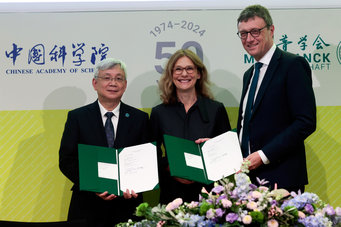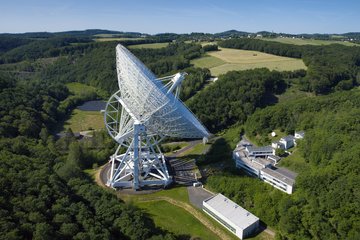“In these challenging times, we as scientists must stand united”
The Max Planck Society (MPG) and the Chinese Academy of Sciences (CAS) are celebrating 50 years of cooperation
From a cautious approach at the beginning, to a systematic exchange of researchers in the 1990s, to the strategic expansion of cooperation in selected priority areas since 2018: Sino-German cooperation between the Max Planck Society and the Chinese Academy of Sciences has gone through various phases since its beginnings in 1974 and has repeatedly adapted to current geopolitical challenges. Today, Max Planck researchers benefit from the historically grown cooperation, for example by having privileged access to the CAS's infrastructures, some of which are unique in the world. These and other success stories illustrate why the MPG continues to work with this top Chinese institution – despite increasing scepticism about China and while maintaining scientific freedom and ensuring the free exchange of data.

On the occasion of the 50th anniversary of the collaboration with the CAS, Max Planck President Patrick Cramer invited guests to the Harnack House in Berlin on 28 October 2024 for scientific workshops and an evening event. Among the approximately 270 invited guests were representatives of the CAS, Max Planck researchers, sponsors and representatives from politics and science. During the day, six scientific workshops were held, reflecting the diversity of the Max Planck Society's collaboration with the CAS – from the history of science to research into biodiversity and climate protection, and fundamental research in physics. At the evening event, a Memorandum of Understanding was signed to establish a summer school programme with the CAS. The MPG hopes that this will enable young scientists to develop expertise and networks in China at an early stage in their careers.
Overcoming global crises together

In his speech, Cramer spoke about the scientific successes and future opportunities for cooperation with China. At the same time, he emphasised the need for a critical and constructive approach in view of the geopolitical challenges that cooperation with China as a whole entails. “In these challenging times, we as scientists must stand united, maintain bridges, and continue to collaborate while avoiding risks. After all, many of the global challenges we face, we can only address by working together.” As examples, Cramer mentioned the global climate crisis, endangered ecosystems and the transformation processes in the chemical industry, among others.
The fact that CAS is an important partner for the MPG in researching solutions is also reflected in the number of joint publications: in the last five years, researchers from the MPG and CAS have published more than 3,700 joint publications in their cooperation projects. This makes CAS the second most important international partner institution for Max Planck, after the French Centre National de la Recherche Scientifique (CNRS) and ahead of the American elite university Harvard.
The following four selected cooperation projects reflect the key areas in which Max Planck benefits from cooperation with Chinese institutions:
Using the world's largest radio telescope to track down extreme stars
One example of the unique infrastructure used by Max Planck is the world's largest radio telescope in southwest China: the Five-hundred-meter Aperture Spherical Telescope (FAST). Michael Kramer from the Max Planck Institute for Radio Astronomy and his team are working closely with researchers from the Chinese Academy of Sciences, who operate the FAST radio telescope. Together, they are studying extreme stars – so-called pulsars. ‘In my field of research, sensitivity is everything,’ says Michael Kramer. ‘That's why we started collaborating with China many years ago. They now operate the largest radio telescope with a diameter of 500 metres after the Arecibo radio telescope unfortunately collapsed in 2020.’ The Max Planck Institute for Radio Astronomy itself has a superclass radio telescope. At 100 metres, it is one of the two largest movable radio telescopes in the world. However, the FAST telescope in China is ten times more sensitive and, in addition, suffers less from man-made interference than the Effelsberg telescope in the Eifel region. The FAST telescope has already detected hundreds of new pulsars across the sky. Effelsberg is ready to quickly target and examine special specimens in more detail. The advantage here is flexibility combined with a still considerable collecting area.
Marilyn Cruces, an astronomer at the Max Planck Institute for Radio Astronomy, led a German-Chinese team that used FAST to discover exceptionally old pulsar stars, as only became apparent after a follow-up study with Effelsberg. ‘Our colleagues in China and we are aware of the tense political situation. Our data are rarely critical, but when they are, we naturally have to pay very close attention. Our research collaboration works so well precisely because we deal with the situation openly and transparently on both sides and do not gloss over anything. It is our common goal to do the best science possible, and that is only possible if we combine the strengths of both telescopes in Germany and China,’ says Kramer.
How are climate change and human activities altering the conditions for life in drylands?
Drylands make up about 40 per cent of the world's land area, and 70 per cent of the world's population lives in these areas. It has always rained little in them, but with climate change they are becoming even drier. In addition, human activities such as agriculture are exacerbating water scarcity and soil erosion in drylands. In the Dryland project, a collaboration between various institutes of the Max Planck Society and the Chinese Academy of Sciences (CAS), researchers are investigating how climate change and changes in land use affect dryland ecosystems and ultimately the food supply of the people living there. For example, a team from the Max Planck Institute for Biogeochemistry and the Research Center for Eco-Environmental Sciences of the CAS is investigating how increasing drought and changing land use affect the carbon balance of dryland ecosystems. In field studies and laboratory experiments in different regions, such as in Spain or on the Loess Plateau in northern Central China, the researchers are investigating the relationship between water availability and carbon balance in detail. Among other things, they are investigating whether plants and soil organisms store less carbon under the changed conditions and thus extract less carbon dioxide from the atmosphere, thereby intensifying global warming.
Regenerative Biomedicine: How can heart tissue be regenerated after a heart attack?
Thomas Braun from the Max Planck Institute for Heart and Lung Research in Bad Nauheim has also been cooperating with various research institutions in China for a long time. The joint Center for Regenerative Biomedicine of the Max Planck Society and the Guangzhou Institute of Biomedicine and Health, which belongs to the CAS, was particularly important. He also maintains collaborations with the Chinese University of Hong Kong, the Tongji Medical College in Huazhong and the University of Science and Technology in Wuhan. Together with his Chinese partners, he has gained important insights into how heart tissue can regenerate after a heart attack.
Unlike fish and amphibians, the heart muscle cells of humans lose their ability to divide very early on in their development. Researchers from Bad Nauheim and China have partially reprogrammed the heart muscle cells of a mouse with a cocktail of four growth factors, thereby rejuvenating them. In this way, highly specialised heart muscle cells are restored to a kind of embryonic state in which they can divide again. The fact that mature heart muscle cells of mammals – and thus also of humans – can regain their ability to divide opens up the possibility of treating heart attack patients using gene therapy.
In addition, Thomas Braun, together with researchers from Guangzhou, has discovered that an intermediate product of energy metabolism increases the division potential of mature heart muscle cells. The enzymes involved could be a target for the development of drugs that increase the heart's ability to regenerate.
The transformation of cosmological conceptions in late imperial China and their influence on knowledge about the environment and life
Dagmar Schäfer, Director at the Max Planck Institute for the History of Science, is particularly interested in the history and sociology of Chinese technology and the paradigms that shape the discourse on technological developments in the past and present. Her workshop, ‘Cosmology in a Living World: Knowledge Regarding Environment and Life in Late Imperial China’, was part of the academic series of events celebrating the 50th anniversary of the collaboration between the Max Planck Society and the Chinese Academy of Sciences (CAS). The workshop examined the transformation of cosmological ideas in late imperial China (1368–1911) and their influence on knowledge about the environment and life. Investigating how cosmological knowledge was localised and integrated into daily life and technological practices reveals that human survival and adaptation has always depended on knowledge of the environment and the universe. Scientists from various institutions – including the Max Planck Institute for the History of Science (MPIWG) and UCAS – came together and exchanged information about the progress of the project virtually and on site. The different expertise and methodologies of the respective institutions complement each other in this approach and, together with the interdisciplinary background of the participants, offer great added value for research. The workshop was also the starting point for various studies that are expected to be published by a Max Planck partner group over the next two to three years.
PM













